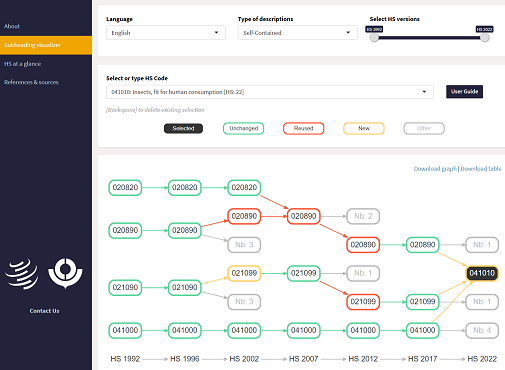Background #
Countries generally report their detailed merchandise trade data in the latest Harmonized Commodity Description and Coding System (HS) version. Yet, some countries report their data in earlier HS versions. Consequently, when querying the data for the latest version of the HS, UN Comtrade only shows data for some available reporters. When querying the data for an earlier version of the HS, users will obtain data reported in this HS version together with data converted to this HS version.
Converted data are obtained from the reported data using the appropriate correlation table [see conversion tables and their methodology.] Please note that if the scope of a heading in one classification is split between scopes of several headings in the other classification, only an approximate correlation is possible. Reported classification is sometimes also referred to as original classification.
Disclaimer:
The data conversions have been developed based on the staff’s best judgment at the Trade Statistics Section (TSS) of the United Nations Statistics Division (UNSD) but have no binding character whatsoever. Data users are free to convert the original data provided by countries to different classifications according to their criteria.
Conversion Issues #
Users should understand the limitations of converted data:
Break in time series continuity #
HS is amended/revised regularly to add, remove, split, or merge commodity codes (see the WCO website for more information). It may cause a break in time series analysis for certain commodity codes.
Consider this example: 2 older commodity codes merged into one commodity code. In this case, data reported in the latest version will be converted to a specific code in an earlier version, resulting in a break in the series for the other codes. Case study: HS2002 codes 010592 and 010593 are merged into HS2007 code 010594. Based on the conversion table, HS2007 code 010594 is converted to HS2002 010592, resulting in a break in series for HS2002 code 010593.
WTO has developed a visualization tool called HSTracker to assist users in tracking HS codes and scope changes.

Loss of confidential information #
Some countries suppress confidential data at four and six-digit levels and may reveal them on two-digit levels. In reported data, the two-digit level may include confidential data (therefore, the sum of two digits is greater than the aggregated corresponding six digits). On the contrary, in converted data, two digits do not contain confidentiality because HS conversion is done on the most detailed level (therefore, the sum of 2 digits equals the sum of 6 digits).
Possible loss of supplementary quantity information #
Supplementary quantity is converted along with trade values. Values can be aggregated straightforwardly for those with split correlations (single old codes split into several new codes). However, net weight and supplementary quantity may not be aggregated because of multiple reported quantity units in the reported classification.
Data Extraction Option #
Because of those issues, it may be more useful for some users to extract data in reported classification across many reporters and years.
Please note that in UN Comtrade, even though all reported and converted data are available through the bulk download UI and API, only HS-reported and selected converted data are accessible through the data UI and API due to a significant increase in data size. For example, querying HS 1992 (H0) is no longer possible through the query interface or data API. Instead, they are accessible through the Bulk interface and API. It means running a query with specific selection criteria is no longer feasible. See more at this FAQ.
For additional metadata, such as the version of the original classification or original currency, please consult the Data availability and metadata.
Note of caution: users should understand some code changes in scope from one version to another. Combining them in one data extraction may result in a break-in time series analysis.


